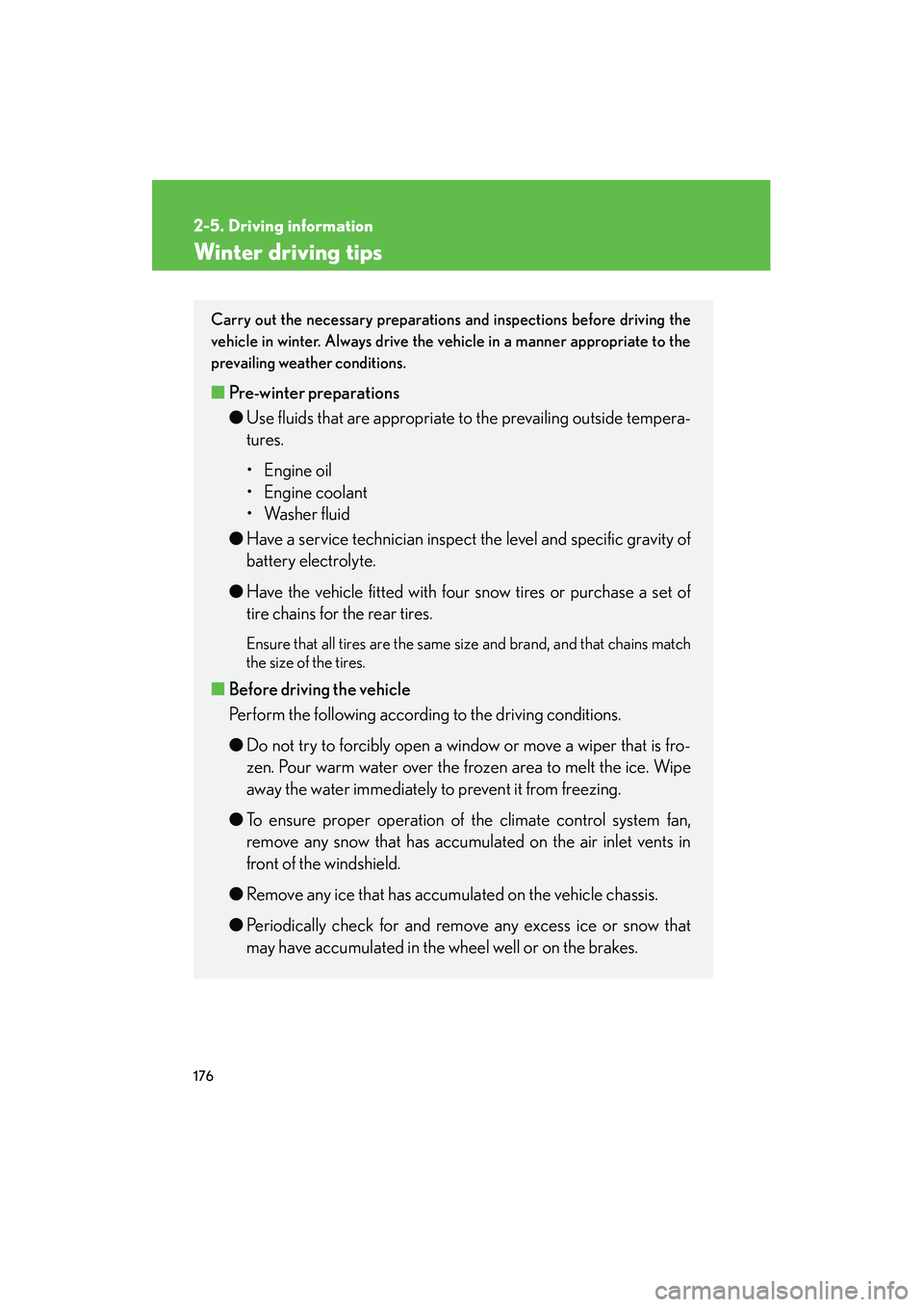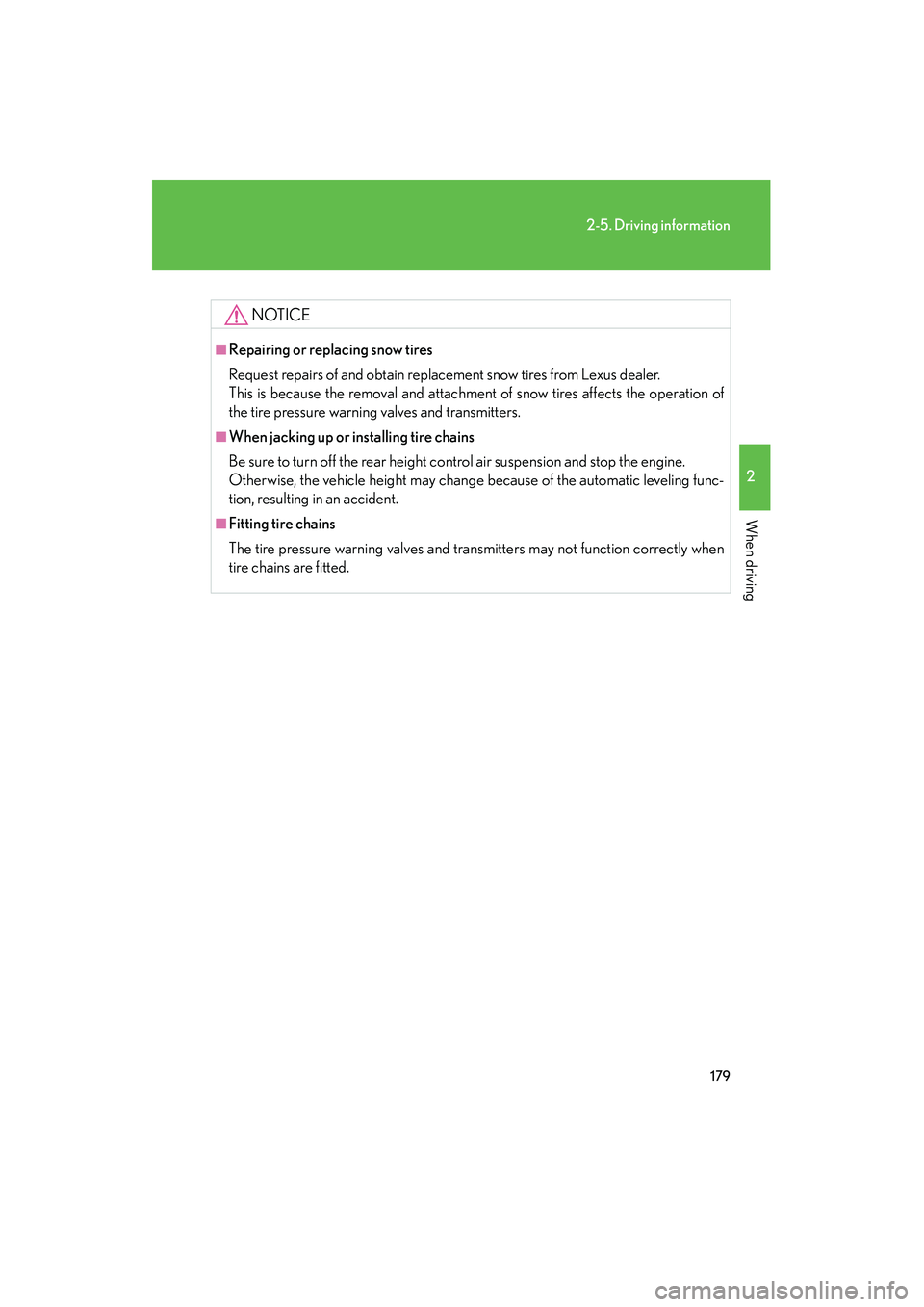Lexus GX470 2008 Owner's Manual
Manufacturer: LEXUS, Model Year: 2008, Model line: GX470, Model: Lexus GX470 2008Pages: 458, PDF Size: 5.93 MB
Page 171 of 458

170
2-5. Driving information
(5) Determine the combined weight of luggage and cargo beingloaded on the vehicle.
That weight may not safely exceed the available cargo and luggage
load capacity calculated in Step 4.
(6) If your vehicle will be towing a trailer, load from your trailer will be transferred to your vehicle. Consult this manual to determine how
this reduces the available cargo and luggage load capacity of your
vehicle. ( →P. 1 74 )
Example on your vehicle
Cargo capacity
Total load capacity
When 2 people with the combined weight of 366 lb. (166 kg) are riding
in your vehicle, the available amount of cargo and luggage load capacity
will be as follows:
• With third seats — total load capacity: 1200 lb. (544 kg) 1200 lb. - 366 lb. = 834 lb. (544 kg - 166 kg = 378 kg)
• Without third seats — total load capacity: 1000 lb. (454 kg) 1000 lb. - 366 lb. = 634 lb. (454 kg - 166 kg = 288 kg)
Page 172 of 458

171
2-5. Driving information
2
When driving
From this condition, if 3 more passengers with the combined weight of
388 lb. (176 kg) get on, the available cargo and luggage load will be
reduced as follows:
• With third seats 834 lb. - 388 lb. = 446 lb. (378 kg - 176 kg = 202 kg)
• Without third seats 634 lb. - 388 lb. = 246 lb. (288 kg - 176 kg = 112 kg)
As shown in the above example, if the number of occupants increases,
the cargo and luggage load equaling the combined weight of the occu-
pants who got on later, by an amount. In other words, if an increase in the
number of occupants causes an excess of the total load capacity (com-
bined weight of occupants plus cargo and luggage load), you must
reduce the cargo and luggage on your vehicle.
Seating configuration variation
Cargo capacity
Weight of removed third seat
If removing the third seat, it is possible to load extra cargo equal to the
weight of the removed seats.
(Cargo capacity) = (Total load capacity) - (Total weight of occupants) +
(Weight of the removed third seats)
Third seat weight: Right side — 30.2 lb. (13.7 kg)
Left side — 32.4 lb. (14.7 kg)
Page 173 of 458

172
2-5. Driving information
CAUTION
■Things that must not be carried in the luggage compartment
The following things may cause a fire if loaded in the luggage compartment:
●Receptacles containing gasoline
●Aerosol cans
■Storage precautions
●Do not place anything on the luggage cover, and do not stack anything in the lug-
gage compartment higher than the seatbacks.
Such items may be thrown about and possibly injure people in the vehicle during
sudden braking or in an accident.
●Do not drive with objects on top of the instrument panel.
They may interfere with the driver’s field of view or move during sharp accelera-
tion or turning, thus impairing the driver’s control of the vehicle. In an accident
they may injure the vehicle occupants.
●Secure all items in the occupant compartment, as they may shift and injure some-
one during an accident or sudden braking.
●Never allow anyone to ride in the luggage compartment. It is not designed for
passengers. They should ride in their seats with their seat belts properly fastened.
Otherwise, they are much more likely to suffer serious bodily injury or death, in
the event of sudden braking or a collision.
■Capacity and distribution
●Do not exceed the maximum axle weight rating or the total vehicle weight rating.
●Even if the total load of occupant’s weight and the cargo load is less than the total
load capacity, do not apply the load unevenly. Improper loading may cause dete-
rioration of steering or braking control which may cause death or serious injury.
■Cross rail adjustment
Make sure the cross rails are locked securely by applying pressure forward and
rearward.
Failure to do so may cause an accident, death or serious injury in the event of emer-
gency braking or a collision.
Page 174 of 458

173
2-5. Driving information
2
When driving
CAUTION
■When loading cargo
Observe the following precautions:
●Place the cargo so that its weight is distributed evenly between the front and rear
axles.
●If loading long or wide cargo, never exceed the vehicle overall length or width.
(→ P. 4 1 2 )
●Before driving, make sure the cargo is securely fastened to the roof luggage car-
rier.
●Loading cargo on the roof luggage carrier will raise the vehicle’s center of gravity.
Avoid high speeds, sudden starts, sharp turns, sudden braking or abrupt maneu-
vers, otherwise unexpected loss of control or vehicle rollover may occur.
●If driving for a long distance, on rough roads, or at high speeds, stop the vehicle
occasionally during the trip to make sure the cargo remains securely fastened.
●Do not exceed 130 lb. (58 kg) cargo weight on the roof luggage carrier.
NOTICE
■When loading the luggage
Be careful not to scratch the surface of the moon roof.
■Cross rail stoppers
To prevent damage the moon roof, do not remove the cross rail stoppers.
Page 175 of 458

174
2-5. Driving information
Vehicle load limits
Vehicle load limits include total load capacity, seating capacity, towing
capacity and cargo capacity.
■Total load capacity:
With third seats — 1200 lb. (544 kg)
Without third seats — 1000 lb. (454 kg)
Total load capacity means the combined weight of occupants, cargo
and luggage.
■ Seating capacity:
With third seats — Total 8 (Front 2, Rear 6)
Without third seats — Total 5 (Front 2, Rear 3)
Seating capacity means the maximu m number of occupants whose
estimated average weight is 150 lb. (68 kg) per person.
Even if the number of occupants are within the seating capacity, do
not exceed the total load capacity.
■ Towing capacity: 6500 lb. (2948 kg)
Towing capacity means the maximum gross trailer weight (trailer
weight plus its cargo weight) that your vehicle is able to tow.
■ Cargo capacity
Cargo capacity may increase or decrease depending on the weight
and the number of occupants.
Page 176 of 458

175
2-5. Driving information
2
When driving
■Total load capacity and seating capacity
These details are also described on the tire and loading information label.
(→ P. 3 4 3 )
CAUTION
■Overloading the vehicle
Do not overload the vehicle.
It may not only cause damage to the tires, but also degrade steering and braking
ability, resulting in an accident.
Page 177 of 458

176
2-5. Driving information
Winter driving tips
Carry out the necessary preparations and inspections before driving the
vehicle in winter. Always drive the vehicle in a manner appropriate to the
prevailing weather conditions.
■Pre-winter preparations
●Use fluids that are appropriate to the prevailing outside tempera-
tures.
• Engine oil
• Engine coolant
• Washer fluid
● Have a service technician inspect the level and specific gravity of
battery electrolyte.
● Have the vehicle fitted with four snow tires or purchase a set of
tire chains for the rear tires.
Ensure that all tires are the same size and brand, and that chains match
the size of the tires.
■ Before driving the vehicle
Perform the following according to the driving conditions.
●Do not try to forcibly open a window or move a wiper that is fro-
zen. Pour warm water over the frozen area to melt the ice. Wipe
away the water immediately to prevent it from freezing.
● To ensure proper operation of the climate control system fan,
remove any snow that has accumulated on the air inlet vents in
front of the windshield.
● Remove any ice that has accumulated on the vehicle chassis.
● Periodically check for and remove any excess ice or snow that
may have accumulated in the wheel well or on the brakes.
Page 178 of 458

177
2-5. Driving information
2
When drivingSelecting snow chains
Use the correct snow chain size when mounting the snow chains. Chain size
is regulated for each tire sizes. Side chain:0.20 in. (5.0 mm)
1.81 in. (46.0 mm)
0.71 in. (18.0 mm)
Cross chain: 0.25 in. (6.3 mm)
1.5 in. (38.1 mm)
0.89 in. (22.6 mm)
Regulations on the use of snow chains
● Regulations regarding the use of tire chains vary according to location
and type of road. Always check local regulations before installing
chains.
● Install the chains on the rear tires.
● Retighten the chains after driving 1 /4 - 1 /2 mile (0.5 - 1.0 km).
■When driving the vehicle
Accelerate the vehicle slowly and drive at a reduced speed suitable
to road conditions.
■ When parking the vehicle
Park the vehicle and move the shift lever to “P” without setting the
parking brake. The parking brake may freeze, preventing it from
being released.
Page 179 of 458

178
2-5. Driving information
■Snow chain installation
Observe the following precautions when installing and removing chains.
●Install and remove tire chains in a safe location.
●Install tire chains on the rear tires.
●Install tire chains in accordance with the accompanying instructions.
CAUTION
■Driving with snow tires
Observe the following precautions to reduce the risk of accidents.
Failing to do so may result in a loss of vehicle control and cause death or serious
injury.
●Use tires of the size specified for your vehicle.
●Maintain the specified level of tire inflation pressure.
●Do not drive in excess of 75 mph (120 km/h), regardless of the type of snow tires
being used.
●Snow tires should be installed on all wheels.
■Driving with snow chains
Observe the following precautions to reduce the risk of accidents.
Failing to do so may result in the vehicle being unable to be driven safely, and may
cause death or serious injury.
●Do not drive in excess of the speed limit specified for the tire chains being used,
or 30 mph (50 km/h), whichever is lower.
●Avoid driving on bumpy road surfaces or over potholes.
●Avoid sudden turns and braking, as use of chains may adversely affect vehicle
handling.
●Slow down sufficiently before entering a curve to ensure that vehicle control is
maintained.
Page 180 of 458

179
2-5. Driving information
2
When driving
NOTICE
■Repairing or replacing snow tires
Request repairs of and obtain replacement snow tires from Lexus dealer.
This is because the removal and attachment of snow tires affects the operation of
the tire pressure warning valves and transmitters.
■When jacking up or installing tire chains
Be sure to turn off the rear height control air suspension and stop the engine.
Otherwise, the vehicle height may change because of the automatic leveling func-
tion, resulting in an accident.
■Fitting tire chains
The tire pressure warning valves and transmitters may not function correctly when
tire chains are fitted.